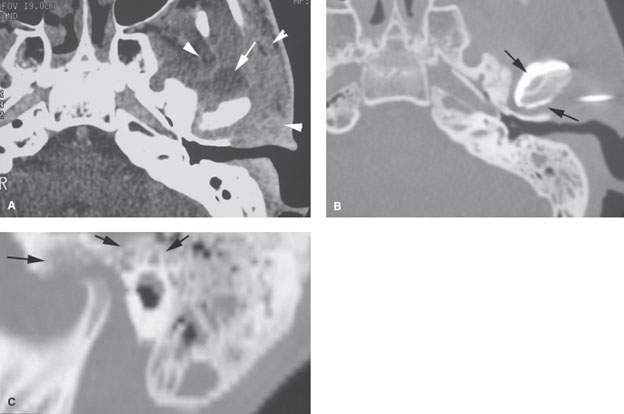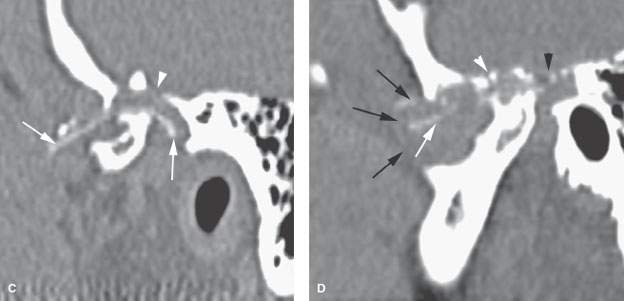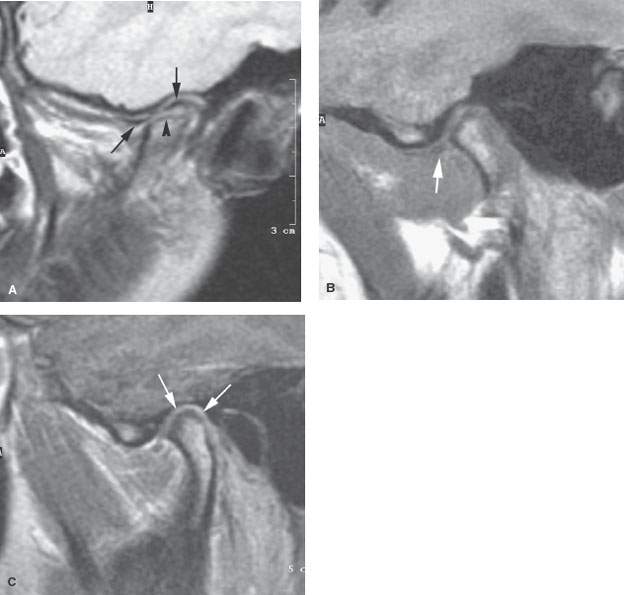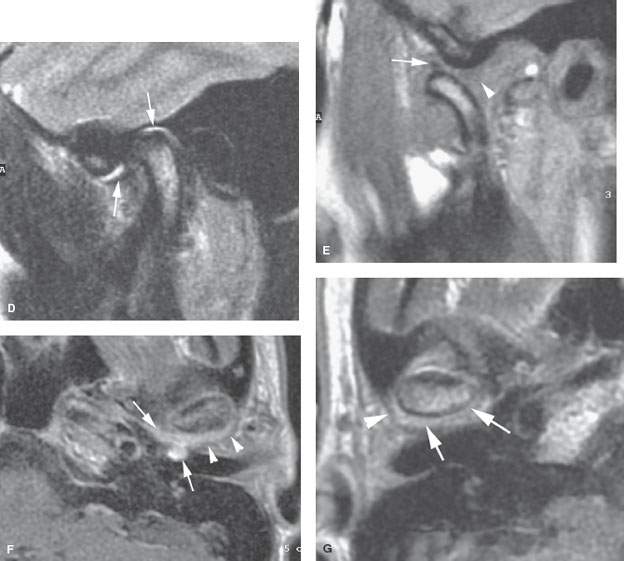TEMPOROMANDIBULAR JOINT: INFLAMMATORY, DEGENERATIVE, AND TRAUMATIC CONDITIONS
KEY POINTS
- Magnetic resonance imaging, computed tomography, and cone beam volume computed tomography are useful and complementary in the evaluation of potential temporomandibular joint internal dearrangements.
- Magnetic resonance imaging is the best study to evaluate the articular disk and other intra-articular soft tissues.
- Magnetic resonance imaging is the best study to provide some information about joint mechanics, the articular disk, and other intra-articular soft tissues.
- Periarticular problems may mimic a primary temporomandibular joint; imaging protocols and evaluation of images must include some attempt to screen the anatomy around the joint.
TECHNICAL ASPECTS
General Examination Technique
The imaging approach to the temporomandibular joint (TMJ) is discussed in Chapter 101, where specific recommendations about section thickness and other image acquisition parameters are suggested. Multidetector computed tomography (MDCT), cone beam volume computed tomography (CBVCT), and magnetic resonance imaging (MRI) are all used for advanced imaging for some indications (Table 4.1). Plain films, including panoramic views, remain a standard and reasonable starting point for the study of the TMJ. Advanced imaging studies are reserved for more complex clinical decision making. Kinematic studies are possible with MRI and 320 MDCT units.
The most common applications of CT for inflammatory and degenerative conditions of the TMJ are done without intravenous (IV) contrast. IV contrast may be used in selected, more complex cases. Specific CT protocols are presented in Appendix A.
Dedicated TMJ MRI is typically done with non–fat-suppressed T1-weighted or density-weighted images and T2-weighted images without IV contrast. Selected cases of inflammatory disease are done before and after IV contrast. Magnetic resonance (MR) protocols are presented in Appendix B.
General Imaging Appearance and Diagnostic Approach
The pathophysiology and general imaging appearance of head and neck infectious diseases are discussed in Chapters 13 and 16, and their effects on bone are discussed in Chapter 14.
Unique features of TMJ pathology to be observed are those related to it being a joint. These observations are therefore similar to any that would be made in synovial joints that have meniscus elsewhere in the body. Critical points of analysis include erosion of the cortical and subchondral bone of both sides of the joint space, synovial changes, joint capsule distention, the contents of the joint space, and periarticular changes.
INFLAMMATORY DISEASES
General Imaging Approach
The evaluation of infectious and noninfectious inflammatory TMJ disease often begins with plain films. Some patients with persistent and especially worsening symptoms after a course of conservative management requiring imaging will get a CT (Fig. 102.1). Means of complying with reducing radiation exposure should be considered in pediatric screening studies. CBVCT fits very well in this paradigm, if available. Patients with chronic complaints after TMJ surgery will typically be studied with non–contrast-enhanced CT and occasionally MRI (Figs. 101.9 and 102.2) when imaging beyond plain films is necessary.
These inflammatory conditions may be infectious, but the TMJ is often involved in inflammatory arthropathy that is autoimmune and already manifested in other joints or due to isolated, acquired, noninfectious synovitis (Figs. 102.3 and 102.4). Inflammatory arthropathies may eventually lead to fibrous and/or bony ankylosis; thus, the restricted opening in this setting will most commonly be evaluated with a progression of studies from plain films to CT to MRI, the latter two studies usually without IV contrast depending on the complexity of medical decision making (Fig. 102.5).
Complex inflammatory cases, posing a risk for associated abscess or other complications, should be studied during infusion of IV contrast (Figs. 102.1, 102.3 and 102.4 and Appendix A). Periarticular inflammatory processes, such as external otitis, sometimes present as a primary TMJ disorder. In such instances, the use of contrast is decided case by case depending on the acuity and associated clinical circumstances (Chapters 114–116).
MRI is used in highly selected circumstances for inflammatory arthropathy (Figs. 102.3 and 102.4).
General Imaging Appearance
The pathophysiology and general imaging appearance of head and neck infectious diseases are discussed in Chapters 13 and 16, and their effects on bone are discussed in Chapter 14.
Unique features of TMJ inflammatory conditions include the capacity to erode the cortical and subchondral bone of both sides of the joint space, cause synovial thickening and enhancement with secondary effusion and joint capsule distention. Periarticular soft tissue edema, phlegmon, and/or abscess may be present (Figs. 102.1–102.4).

FIGURE 102.1. Computed tomography (CT) study of a patient believed to have a tumor producing swelling in the vicinity of the left temporomandibular joint (TMJ) based on imaging at another institution. The patient presented to our institution for CT-directed biopsy. A: Preliminary diagnostic contrast-enhanced CT for biopsy planning, showing generalized swelling around the TMJ (arrowheads) and a discreet fluid collection (arrow). These findings were considered to possibly be due to an inflammatory process related to the TMJ because of the proximity of the fluid collection to the condylar head. B: Instead of a biopsy, a needle was inserted into the TMJ and contrast injected (arrowheads). This shows that the fluid collection was not in the joint space. The fluid collection was then aspirated and showed purulent material. C: The source of the periarticular infection proved to be chronic mastoid disease that secondarily spread to air cells populating the root of the zygoma and condylar fossa (arrows). The patient was subsequently cured with antibiotics.
Bilateral abnormalities suggest a systemic etiology (Figs. 102.3 and 102.5).
Infections
Septic TMJ arthropathy is a relatively rare condition, while acute or subacute periarticular infection is much more common (Fig. 102.1) and most typically form a source other than the TMJ. The periarticular infections are mainly secondary to mastoiditis, necrotizing external otitis, or part of some other skull base osteomyelitis. Those conditions are discussed in Chapters 114 through 116.


FIGURE 102.2. Nonautogenous material used to reconstruct the temporomandibular joint (TMJ) often results in chronic inflammatory disease. This computed tomography study was done in a patient experiencing bilateral TMJ pain and limitation of range of motion following Proplast implants. A: Anchoring material has loosened from the root of the zygoma (arrows). B: Coronal reformation showing the implanted material (arrows) surrounded by abnormal soft tissue that erodes the bone of the condylar fossa down to the dural and periosteal interface (arrowheads). C: Intermediate window sagittal reformations showing the likely fragmentation of the Proplast reconstructed joint surface (arrows) and erosion of the condylar fossa on one side. D: On the opposite side, the implanted material is even more fragmented (white arrow), and there is very extensive erosion of the floor of the middle cranial fossa and condylar fossa (arrowheads). The joint capsule is markedly distended (black arrows).


FIGURE 102.3. Two patients with inflammatory arthritis studied with contrast-enhanced magnetic resonance (CEMR). A: Patient 1 with juvenile rheumatoid arthritis showing the condylar head to be somewhat flattened but not unusually small in contrast to Figure 102.8A (arrowhead). The articular disk is thinner than usual and appears stretched out over the condylar head more than usual (arrows). This disk could be centrally perforated based on this study, but such findings generally prove to be unreliable compared to arthroscopic findings. B–G: Patient 2. CEMR showing bilateral temporomandibular joint synovitis and an abnormal mass presenting near the tympanic ring. In (B), the non–contrast-enhanced T1-weighted (T1W) image shows a dysmorphic, thin articular disk (arrow) anteriorly displaced. In (C), the contrast-enhanced T1W image shows that the articular disk is difficult to identify and that there is enhancement of the synovium (arrows). In (D), T2-weighted magnetic resonance shows joint space effusion (arrow). In (E), in the open position, the non–contrast-enhanced T1W image shows the anterior band (arrow) to be in relatively normal position and a dysmorphic posterior band to be barely visible (arrowhead), but that the disk has recaptured. In (F), the contrast-enhanced T1W axial image shows the joint capsule (arrowheads) distended by enhancing synovium that has protruded into the external auditory canal near the tympanic ring (arrows). The synovium appears to have herniated through the joint capsule. In (G), on the opposite side, the distended joint capsule is filled with enhancing synovium (arrow) and slightly distended without synovial herniation as seen on the opposite side.
Stay updated, free articles. Join our Telegram channel

Full access? Get Clinical Tree








